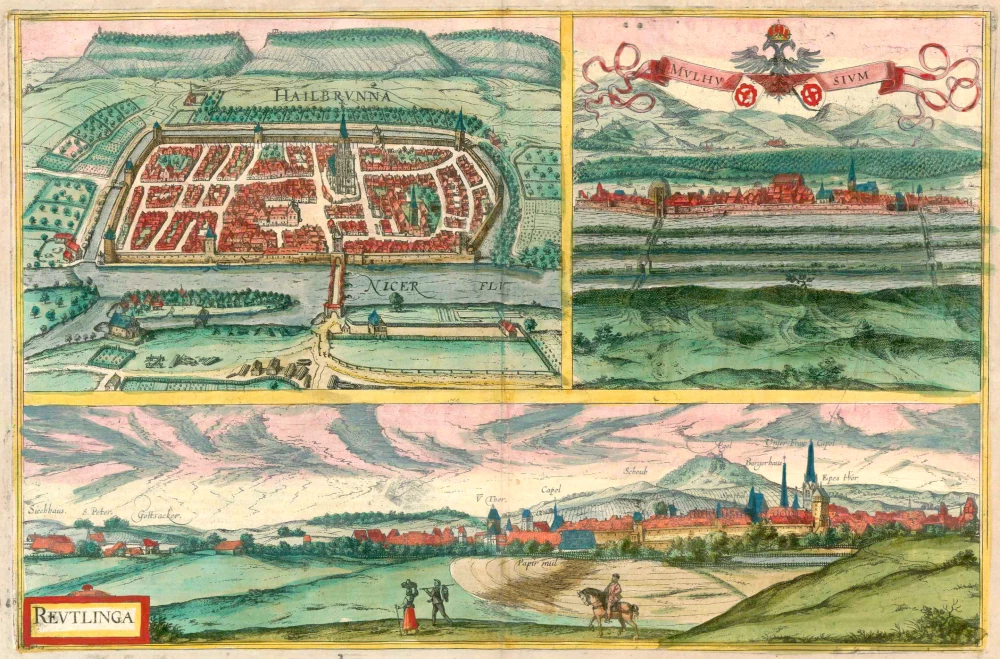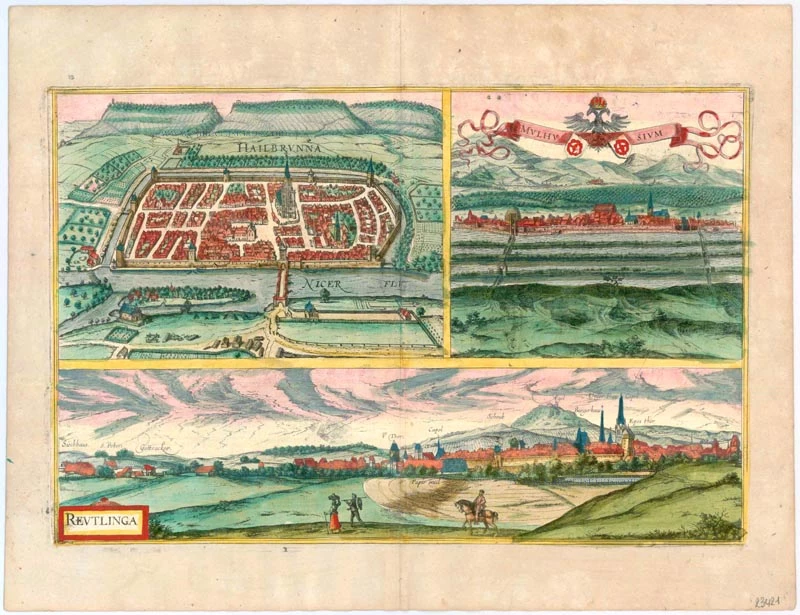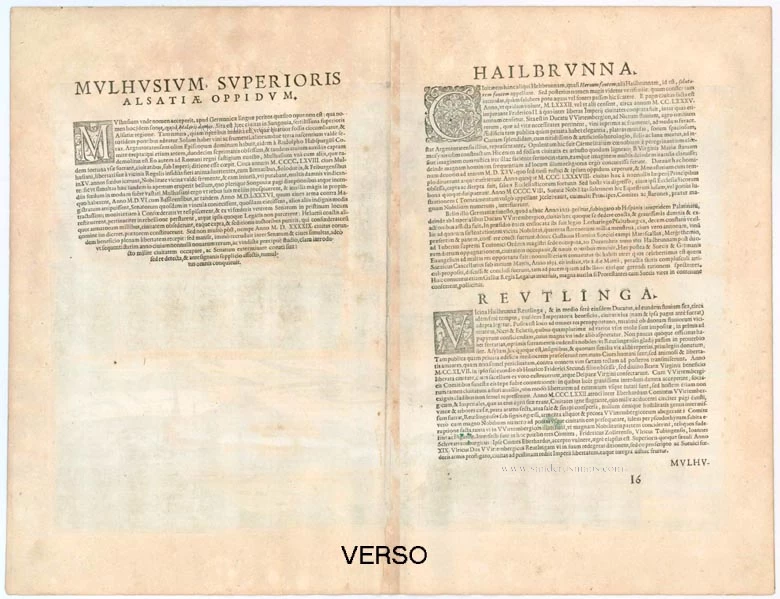Heilbronn - Mulhouse - Reutlingen by Braun & Hogenberg 1618
HEILBRONN
COMMENTARY BY BRAUN (on verso): "Several believe that the name of this city is Heldenbrunn, but others call it Hellbrunn because of the healthy and healing water found here. It grew from a village into a town and was surrounded with walls in the year 1082 or, as claimed by some, in the year 1285 and was granted a municipal charter by Emperor Frederick II."
This is a view from the west over the Neckar of the fortified city centre with the larger-than-life-size church of St Kilian. On the marketplace's northwest of it is the town hall with the famous ornate clock by Isaak Habrecht of Strasbourg. Orchards and vegetable gardens, fields and vineyards surround the city. Unfortunately, very few of Heilbronn's historic buildings still stand today, for the Old Town was almost completely destroyed in the Second World War.
MULHOUSE IN ALSACE
COMMENTARY BY BRAUN (on verso): "As far as this city is concerned, it is very well fortified and protected by nature and its surroundings as well as by thick walls, ditches and similar constructions, in particular, there are four moats and over each a bridge that must be crossed before one can enter the city. The soil in the surrounding countryside produces corn and wine and all kinds of fruit in great abundance."
From a slightly raised position, this view from the west shows the city behind its four moats. The late Romanesque church of St Stephen dates from the 12th century. In the background, the Vosges Mountains can be seen. Mulhouse was once a Free Imperial City and was associated with the Old Swiss Confederacy for a long time.
REUTLINGEN
COMMENTARY BY BRAUN (on verso): "The position of this city is ideal for various industries; there are numerous mills, and a great deal of paper is made and exported far and wide. The city has engaged in many battles with the Counts and Dukes of Württemberg. Although it often suffered no little damage, it has not only defended and safeguarded its liberties and rights with the aid of its allies and neighbouring cities but ha. Still, it has defeated the enemy more than once."
This view from the southwest shows a well-fortified city, behind which vineyards and the dominant cone-shaped Achalm Hill with the imperial castle can be seen. Reutlingen, granted a municipal charter in 1209, became an important centre of trade and craft industries, including book printing. During a period of great prosperity (13th-14th cent.), the magnificent Gothic church of St Mary was built, a proud symbol of the status of Reutlingen was involved in various armed conflicts during the 16th century.
Hailbrunna [on sheet with:] Mulhusium [and] Reutlinga
Item Number: 23421 Authenticity Guarantee
Category: Antique maps > Europe > Germany - Cities
Heilbronn - Mulhouse - Reutlingen by Braun & Hogenberg.
Title: Hailbrunna [on sheet with:] Mulhusium [and] Reutlinga.
Date of the first edition: 1617.
Date of this map: 1618.
Copper engraving, printed on paper.
Size (not including margins): 310 x 478mm (12.2 x 18.82 inches).
Verso: Latin text.
Condition: Excellent, superb old colour.
Condition Rating: A+.
From: Theatri praecipuarum Totius Mundi Urbium Liber Sextus Anno MDCXVIII. (Van der Krogt 4, 41:1.6)
HEILBRONN
COMMENTARY BY BRAUN (on verso): "Several believe that the name of this city is Heldenbrunn, but others call it Hellbrunn because of the healthy and healing water found here. It grew from a village into a town and was surrounded with walls in the year 1082 or, as claimed by some, in the year 1285 and was granted a municipal charter by Emperor Frederick II."
This is a view from the west over the Neckar of the fortified city centre with the larger-than-life-size church of St Kilian. On the marketplace's northwest of it is the town hall with the famous ornate clock by Isaak Habrecht of Strasbourg. Orchards and vegetable gardens, fields and vineyards surround the city. Unfortunately, very few of Heilbronn's historic buildings still stand today, for the Old Town was almost completely destroyed in the Second World War.
MULHOUSE IN ALSACE
COMMENTARY BY BRAUN (on verso): "As far as this city is concerned, it is very well fortified and protected by nature and its surroundings as well as by thick walls, ditches and similar constructions, in particular, there are four moats and over each a bridge that must be crossed before one can enter the city. The soil in the surrounding countryside produces corn and wine and all kinds of fruit in great abundance."
From a slightly raised position, this view from the west shows the city behind its four moats. The late Romanesque church of St Stephen dates from the 12th century. In the background, the Vosges Mountains can be seen. Mulhouse was once a Free Imperial City and was associated with the Old Swiss Confederacy for a long time.
REUTLINGEN
COMMENTARY BY BRAUN (on verso): "The position of this city is ideal for various industries; there are numerous mills, and a great deal of paper is made and exported far and wide. The city has engaged in many battles with the Counts and Dukes of Württemberg. Although it often suffered no little damage, it has not only defended and safeguarded its liberties and rights with the aid of its allies and neighbouring cities but ha. Still, it has defeated the enemy more than once."
This view from the southwest shows a well-fortified city, behind which vineyards and the dominant cone-shaped Achalm Hill with the imperial castle can be seen. Reutlingen, granted a municipal charter in 1209, became an important centre of trade and craft industries, including book printing. During a period of great prosperity (13th-14th cent.), the magnificent Gothic church of St Mary was built, a proud symbol of the status of Reutlingen was involved in various armed conflicts during the 16th century.






